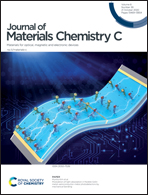Antimony doped lead-free double perovskites (Cs2NaBi1−xSbxCl6) with enhanced light absorption and tunable emission†
Abstract
Recently, compositional engineering of lead-free halide double perovskite materials (A2B+B3+X6) has attracted increasing research interest in terms of potential optoelectronic applications. Herein, antimony (Sb3+) ions are introduced to manipulate the structure and optical properties of Cs2NaBiCl6. Within the substitution range of 30%, the alloyed Cs2NaBi1−xSbxCl6 crystals maintain the pure double perovskite phase while exhibiting a gradually decreasing band-gap. Through controlled oxidation of Sb3+ ions, the samples, even at low alloy levels, show enhanced visible light absorption. An apparent color change from yellow to brown can be observed and ascribed to the increase of defect states. Meanwhile, the emissions of Cs2NaBi1−xSbxCl6 crystals turned gradually from the broad-band orange-red region to the blue-green region with the increase of the Sb3+ content. The dual-emission phenomenon can be attributed to the radiative recombination of self-trapping excitons activated by the excitation energy from the host lattice. This study augments the frontiers of halide double perovskites and deepens the understanding of optoelectronic tuning by atomic substitution. New possibilities in photovoltaics and white light emission applications could be envisioned.



 Please wait while we load your content...
Please wait while we load your content...